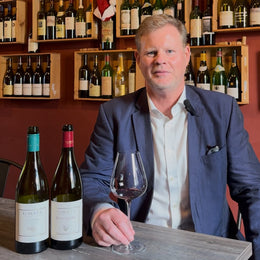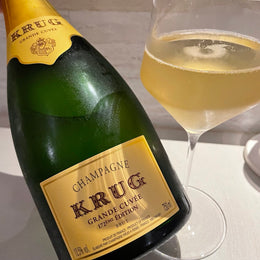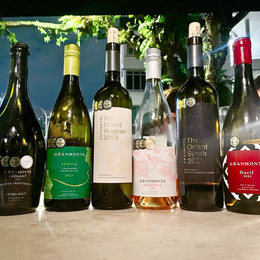A Tale Of Two Pichon's: Taste Testing The Chateau Pichon Longueville Comtesse de Lalande vs. Chateau Pichon Baron

The Pichon's are Bordeaux royalty - both of them, the Pichon Comtesse de Lalande and the Pichon Baron - and are not only incredibly recognisable and almost synonymous with the Left Bank Haut-Medoc region of Pauillac, but are reference marks that must be talked about when talking about the fabled region's wines.
But they're also rather confusing, both with similar and also pretty long names - it's not a hard guess to make that they're related and so today we're going to talk about them, and also put them to a head to head taste test.
So here goes!


The Pichon Longueville vineyards.
The two Chateaux Pichon Comtesse (or sometimes called Pichon Lalande) and Pichon Baron were at the very beginning one unified vineyard - in fact, they were once one of the largest estates in Bordeaux.
This massive estate was created in the 1600's by a very illustrious Pierre Mazure de Rauzan. Now if you're familiar with Bordeaux names, you might notice that the Rauzan name too can be found in the names of several other notable Chateaux, most famously Chateau Rauzan-Segla. Rauzan had an incredible eye for top quality estates in the area, and had come to acquire numerous estates, all of which are classified growths (and were thus ranked in the landmark 1855 Bordeaux Classification). After all, Rauzan was himself the estate manager of the legendary First Growth, Chateau Latour, through which he snapped up land around the Pauillac.

The Bordeaux Royal Palace.
Now going deeper into Pichon lore, you'll also notice that in the full names of both chateaux, there's the name "Longueville", which comes from a Jacques de Pichon Longueville. It was upon the marriage of Rauzan's daughter to Jacques, that the estate was bequeathed to the couple. Jacques was just as illustrious as his father-in-law, and would do well helming the estate to prosperity. He would even be recognised for his world, by being elected as the first President of the Bordeaux Parliament.

Map of Pauillac.
The estate would continue to remain as one for just one more generation, having been passed on to the third-generation Baron Joseph de Pichon Longueville. Although Baron was just 19 when he had taken over the family's estate, he would manage the estate until he was 90 - it was upon the eve of his passing in 1850, that he would make a decision that would reshape the Pauillac region till this day. Desiring to be fair to all his children - 2 sons and 3 daughters - he would equally divide the estate as such, with his 2 sons inheriting 2/5 of the estate, and his daughters inheriting 3/5 of the estate.

A classic Bordeaux head to head!
Shortly after his death, the massive estate would be divided into two - and hence Pichon Baron for his sons, and Pichon Comtesse (Lalande) for the daughters. Whilst this may seem like a simple division that resulted in two different estates, it is often said that this split runs deeper - for it has deeply influenced the styles of the wines produced at the two estates! It is recognised largely by the wine community that whilst Pichon Comtesse dons a more sensuous style - perfumed and rich - which was preferable for the daughters; Pichon Baron is comparatively more muscular and bold, reflecting the strength of the sons.
We'll find out if that's indeed true in just a bit!
More About Pichon Comtesse (Lalande)

At this juncture, with both estates having carved for themselves their own vineyards and reputation, let's dig into what's gone on down at Pichon Comtesse first.
When the giant Pichon Longueville was divided, the sons by way of Pichon Baron, were given the Chateau, along with a smaller parcel of the vines, whilst the daughters were given a larger parcel of vines but without a Chateau. And thus the first order of business for Pichon Comtesse was to design and build a Chateau of their own. Of the three sisters, it was Virginie who took the lead on this, and would have the chateau be designed in the likeness of the Hotel de Lalande, where her husband had grown up around.

Virginie de Pichon Longueville, who built Pichon Comtesse's chateau.
Over the next century and a half, the estate would only be owned by two families, that of the de Pichon Longueville's, and the Miailhe's who had came to acquire the estate later on. Thankfully the estate had always been very well-managed, and each set of hands that took its turn to helm the estate has done it better than the last. The estate grew in stature and size! In fact it grew more than 50% over the coming years. For over 250 years the estate built its esteem.
It was only until 2007 that the estate's new era would arrive - it would be acquired by the family behind the incredibly popular Roederer Champagne. Under the new owners, the estate's infrastructure was updated and steps were taken to improve the estate's wines (such as replantings, the conversion to biodynamic farming, and installing the facilities necessary for single parcel vinification), from the fields all the way to the cellars. All this has started to begin to pay off as the 2016 vintage was highly lauded by the wine community.

The Pichon Comtesse Chateau.
Going into the vineyards, the Chateau Pichon Comtesse is a 100-hectare vineyard planted with 65% Cabernet Sauvignon, 25% Merlot, 7% Cabernet Franc and 3% Petit Verdot. Over the years, the estate has shifted to increase its planting of Cabernet Sauvignon, in place of the other varietals. The terroir of the estate can be characterised by deep gravel, with clay and limestone soils. Worth noting is that Pichon Comtesse is largely surrounding by the legendary Chateau Latour (and then also flanking Pichon Baron), and thus shares much of the same terroir. On average the vines are 40 years old, with the oldest vines being close to 90 years old, having been planted in the 1930's.
Vinification at the chateau is large scale and also done quite precisely in stainless steel vats, after which the wines are aged in 50% new French oak barrels for an average of 18 months.
Looking ahead to the future, Pichon Comtesse's fans can look forward to a greater showing of the estate's own white Bordeaux wine. Starting from the 2022 vintage, Pichon Comtesse had begun producing white wines for the first time in its history - a blend of Chardonnay and Savagnin.
More About Pichon Baron

Much like Pichon Comtesse, Pichon Baron too would change hands by the early 1900's, having been acquired by the Bouteiller family in 1933, who were also established in the French wine scene as descendants of the official wine steward to the King, and had also owned Chateau Lanessan.
The 1960's and 1970's would prove to be a difficult time for Pichon Baron, where it lacked investment needed to upkeep the estate, that was up until the late 1980's when French insurance giant AXA had acquired the estate. AXA immediately brought in Jean-Michel Cazes from Chateau Lynch Bages to help bring the estate up to speed. Major renovations were in order and the vineyards had to be replanted.

Also with the help of Jean-Rene Matignon, the estate began to re-establish its quality into the 1990's through the stopping of machine harvesting, increasing the proportion of Cabernet Sauvignon planted, with also a heavy emphasis on greater sorting and selection with the help of optical sorting technology, as well as a larger proportion of its fruit put to the Chateau's second wine instead, cutting the Grand Vin's production by half.

Pichon Baron's chateau.
Heading into the vineyards, the 73 hectare Pichon Baron is planted with 65% Cabernet Sauvignon, 30% Merlot, 3% Cabernet Franc and 2% Petit Verdot, with the Cabernet Franc and Petit Verdot only used for the second wine. The vineyards are planted to a density of 9,000 vines per hectare, with the soil characterised by having deep gravel, sand and clay soils, and vines averaging up to 65 years old.
Sorting and vinification is a big focus for Pichon Baron. After sorting, the Chateau has 44 stainless steel tanks, 8 oak tanks (only for the Merlot), and 21 amphora vats (for the Petit Verdot) of varying sizes to vinify each variety and parcel separately on a plot-by-plot basis for total precision. The wines are aged in an average of 80% new French oak barrels for 18 months before bottling.
The Differences Summarised!
And thus the primary difference between Pichon Baron and Pichon Comtesse is that the former's soils have more sand instead of limestone, and typically uses a blend of 60% Cabernet Sauvignon and 40% Merlot, as opposed to 78% Cabernet Sauvignon, 17% Merlot and 5% Cabernet Franc for the Pichon Comtesse, with the Pichon Baron also on average using a higher percentage of new French oak.
Wine Review: Chateau Pichon Longueville Comtesse de Lalande 2020

Tasting Notes
Colour: Dark Ruby
Aroma: Immediately chocolate-y, it's a whole lot of rich and decadent chocolate sauce here, weaved together in a velvety manner that's rich yet satin-like - very, very sensual indeed. There's a base of dense and dark scents of cooked plums and prunes, almost giving plum pie and fruitcake. It's accompanied by leather and tobacco. A little bit of barnyard rusticity of horse fur. With time there's more on roses and potpourri. Incredibly dark, rich and velvety.
Taste: Really plush on the palate, the richness carries through. It has an impressive cohesiveness, almost as if everything is perfectly integrated and bounded in unity. Raspberries, blackberries, tobacco, roses. It's entirely silky and velvety, the tannins almost satin like, apparent yet fine. Despite the richness, it's not heavy and has an almost lightness to it. Medium-bodied. Some gentle minty notes of eucalyptus.
Finish: More vanilla sauce comes through here, along with rich notes of cherry pie, plum pie, berry crumble. It maintains that plushness and richness into the finish. Yet along the way it evolves into a lifted quality, in a fully seamless manner. Some tobacco lingers, along with some more of that black cherry pie of a berry crumble, topped with a generous serving of vanilla sauce.

My Thoughts
Sensual is the perfect way to describe this - indeed it's rich and velvety, with such a depth that draws you in, almost like a satin abyss. It's dark and rich on the nose, giving lots of dark chocolate sauce, and incredibly cohesive on the palate, almost coming together perfectly as one, finally following up with a seamlessness into the finish where it begins to lift and brighten, nevertheless keeping that plush richness all the way through. It's incredibly aromatic on the nose, firm on the body, with tannins that are apparent yet completely softened and silky weaving in all that richness. It also has an elegance about it where despite the seemingly heavy and rich dark notes, it's lifted and silky, with a fuller flavour and lustrous body.
Wine Review: Chateau Pichon Baron 2020

Tasting Notes
Colour: Dark Garnet
Aroma: Incredibly richness and cohesiveness here as well, with this being more powerfully aromatic and in full bloom. The bouquet here is open and radiant, all surrounding. It's heavy on the raspberry and blackberries, with a more prominent earthiness and barnyard quality of freshly toiled soil and horse fur. Really vibrant here. With time, more on tobacco and browned leaves.
Taste: The power and richness carries through here, with also more depth and even more roundedness and cohesiveness. Raspberry and blackberry jams, tobacco, the body here is fuller, with some soil too. It's more earthy and heavily rich, certainly more muscular and bolder. Medium-bodied, but again, not heavy.
Finish: Intensely rich into the finish, still very plush and velvety. Loads of raspberry and blackberry jams, with a side of fresh soil and tobacco. The tannins are fine and less prominent, coated by those berry jams. It ends with some minerality and salinity.

My Thoughts
Wow! This is incredibly impressive! This was powerful and vibrant, with its richness reverberating through the entire experience. On the nose the bouquet is wide open and all surrounding! It's in fact radiant, and admittedly more open and intense as compared to the Lalande (or Comtesse). When we get to the palate, it's again much more domineering and forward, with bold and commanding flavours that are also richer and with more depth. Yet at the same time, it's remarkably cohesive, rounded and plush all the way through. The expressiveness of the Baron is wildly energetic and vigorous - such power and elegance!
The flavours here are less confectionary, yet at the same time sweeter on the berry front, with less chocolates and vanilla as compared to the Lalande, the description of sensualness would not be applied here, where it's really alot more muscular and almost in-your-face and maximalist. It also has a nice mineral complexity into the finish, and has an overall more earthy quality to it.

The Conclusion
Between the two, I have to say that I am on the whole more a fan of the Pichon Baron simply because it's so domineering, with such a commanding presence! It's powerfully expressive and vibrant, with a flavour profile that is more earthy and jammy which I personally enjoy. For me, the Pichon Baron is both powerful, radiant, and has still a really incredibly amount of elegance to its plush richness. It's certainly not as sensual or silky, and in a way glosses over its structure more so than the Pichon Lalande.
That said, I can see the appeal of the Pichon Lalande (Comtesse), which is still an entirely impressive classically Bordeaux red that is also comparatively richer and more expressive, and way more cohesive than most of what you'd find in the region - the Pichon Lalande is certainly more subtle and elegant, less in your face, and in a way more refined, and perhaps could be felt to be more of a timeless classic that doesn't wear on the palate, or get too overwhelming and therefore over played. Something also has to be said about how with the Lalande, you can trace the outline of its structure much more, with more nuance and definition, as compared to the Baron, even if it does trade off some of that star power and spectacle.
Ultimately, a wonderful experience to compare them side by side!
Kanpai!

@111hotpot







